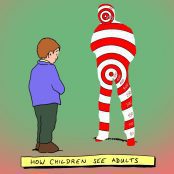[dropcap style=”font-size:100px; color:#992211;”]O[/dropcap]f course, enlightened parents would never have a television in their home.
Falling literacy, increased violent tendencies, obesity and disturbed sleep patterns are just a few of the detrimental effects of letting children have too much time watching TV.
Plus, it really cuts into their Plants Vs Zombies scores.
TVs falling onto children are causing an increasing number of severe neck and head injuries, according to a new paper published today in the Journal of Neurosurgery: Pediatrics.
The rate of these injuries has increased in the last decade and is expected to continue rising as TVs are becoming increasingly large and affordable. TVs are found in 95 per cent of Canadian households, and many aren’t properly fixed to walls or stable bases. As TVs become heavier, they’re more likely to cause fractures and intracranial hemorrhages, which can be fatal.
“Parents have to be aware that TVs can seriously harm children,” said Dr. Michael Cusimano, a neurosurgeon at St. Michael’s Hospital and lead author of the paper. “But these injuries are highly predictable and preventable.”
Dr. Cusimano said children between one and three years old are most susceptible to these injuries and more likely to suffer severe injuries than older children. Many of these injuries occur when toddlers climb onto furniture to retrieve toys or bump into unstable TV bases, causing TVs to topple onto their heads. Because toddlers are usually shorter than most TV stands, their head is most often the first point of contact when a TV falls.
The paper looked at 29 studies from seven countries analyzing TV-related head and neck injuries. The researchers found that 84 per cent of reported injuries occurred at home, with three-fourths of these injuries not witnessed by adult caregivers.
“TVs are often placed on unstable bases, placed on high furniture like dressers, which aren’t designed for TVs, or not properly secured to the wall,” said Dr. Cusimano. “Meanwhile, parents are getting busier and busier and don’t have as much time to supervise children, so it’s not surprising that these injuries are getting reported more often.”
The paper also found that children between two and five years old have significant exposure to TVs – spending more than 32 hours per week in front of TVs – making them susceptible to these sorts of injuries.
Dr. Cusimano compiled a list of methods to help prevent children from sustaining such injuries. These include:
- Educating children, parents, teachers and medical professionals about the dangers of toppling TVs
- Avoiding placing toys or remotes on top of TVs
- Having manufacturers include instructions on how to safely secure TVs to walls or bases
- Placing TVs away from the edge of a stand
- Setting regulations on the kinds of support furniture and wall mounts used for TVs
- Establishing regulations for anchoring TVs to the ground or wall
- Having manufacturers produce shorter, more stable TV stands
“Too many children are sustaining head trauma from an easily preventable TV toppling event,” said Dr. Cusimano. “We hope clinicians take a more active role as advocates for prevention of these injuries, legislators become more open to implementing changes to current regulations, and caregivers employ the suggested prevention strategies at home.”
Source: Eurekalert/St. Michael’s Hospital
Image: Dan Booth. Not to be reproduced without express permission

Some of the news that we find inspiring, diverting, wrong or so very right.




















